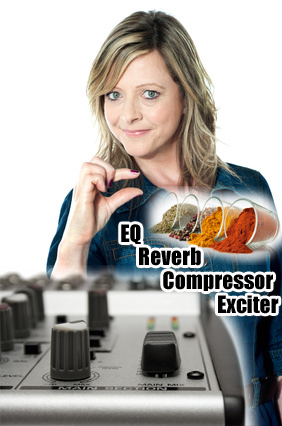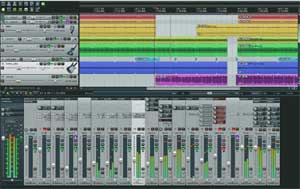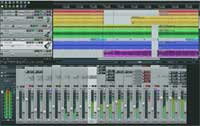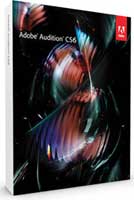Regardless of what your audio track is for, there’s always room for improvement in post-production. Tweaking the stereo, adjusting the EQ, or even just giving the track more of a polished feel are all very important. Using the right tool for the job can improve product quality, but with so many tools and so many jobs, where do you even start? Knowing what changes to make, or at least some common areas that need to be adjusted, can really help you get started.
The article that follows lists several tools – not software programs, mind you – but the tools you can find both as software or hardware, though in today’s home studio, we’ll mostly be talking software. All 10 of the tools mentioned (such as EQ, limiters, compressors, etc.) can be found in most audio editing programs, such as Adobe Audition or Sound Forge. Personally, I use Audition for post production work (primarily mastering). But other programs are just as good.
Take a look at this great set of post production tools and some of their suggested applications: http://www.prosoundweb.com/article/top_ten_must_have_audio_tools_for_post_production/
mastering
Give Your Track A Final Polish With Audio Mastering
After listening to your tracks countless times in a row, it’s hard to make precise, objective decisions about the minute details. A mastering engineer has both the experience and equipment to make the various tweaks and adjustments (balance, stereo image, EQ, etc.) that add up to make a big difference. There’s a whole lot more that can be done in today’s modest home recording studio than used to be possible, but there are some things that really are best left to the thousands-of-dollars setups of mastering engineers. For a review of what mastering is, see our post – Mastering a Song – What Does It Mean?
Read more about audio mastering and its benefits here: http://www.audio-issues.com/mastering/audio-mastering-important/
Effects On the Master Mix Fader – A Little Goes A Long Way
 When mixing a multi-track project, there comes a time when you’re “done” and ready to mix it down (often called “rendering” these days). For a review on what it means to mix something down, see our post here: What Does It Mean To Mix Down Audio? Anyway, you may have a song that is 20, 30, or even 40 tracks or more. During mix-down, the outputs of all of those tracks go into the master track, which then puts out the final stereo signal (usually an audio file like a wav).
When mixing a multi-track project, there comes a time when you’re “done” and ready to mix it down (often called “rendering” these days). For a review on what it means to mix something down, see our post here: What Does It Mean To Mix Down Audio? Anyway, you may have a song that is 20, 30, or even 40 tracks or more. During mix-down, the outputs of all of those tracks go into the master track, which then puts out the final stereo signal (usually an audio file like a wav).
Well this final “master” track, sometimes called the master buss, can have effects applied to it just like the individual tracks, except that any effect applied to the master track will affect everything – every track. For that reason, it is advisable to use any effect at that stage VERY sparingly. The only things I ever do to a master track are adjust the peak volume either by using the master fader control, or by applying a limiter effect to prevent any clipping or distortion in the final mix. Personally I never put any EQ or exciters, or any other tone-altering effect on the master track. I prefer to create a final mix with only the individual track effects applied. Then during the “mastering” stage (see our post What Does Mastering a Song Mean?), I’ll add whatever effects I think will improve the final audio (using audio editing software like Adobe Audition, which has excellent mastering tools. Another good choice is Sound Forge). If it doesn’t sound right, I can always undo the effect at that stage and try something different. But that is hard to do when you’ve already applied the effect to the file during the mix-down process.
Here is an article by Graham Cochrane about this whole idea: http://therecordingrevolution.com/2012/10/29/go-easy-on-the-mix-buss/
Ready Your Mixes For The Mastering Engineer
I have mentioned in the past – see our post Recording Engineer, Mix Engineer and Mastering Engineer – Oh My – that there are really 3 distinct jobs when recording, especially for music:
- Recording (sometimes called “tracking”)
- Mixing
- Mastering
When we record from our home studios, we often do all three things, but there is a lot of benefit to drawing at least a mental line between all 3 jobs. It helps us to refocus and think a bit differently about what we’re doing.
But if you are going to send your music project to a mastering engineer – which is a really good idea, BTW – then there are some things you can do not only to make life easier for the mastering folks, but to get your project produced faster and sounding better.
In this article, Bobby Owsisnksi outlines 8 tips for making your mixes more master-friendly. I would add one tip to the list though, and that would be to leave some headroom in the final mix-down (rendered stereo file of the mix). This gives the mastering engineer room to work with and optimize the final level of the song. If you send in a compressed and normalized audio file, the mastering engineer doesn’t really have breathing room to allow space and “air” to come through in the final version.
But without further ado, here is the original article to which I refer:
http://www.prosoundweb.com/article/in_the_studio_eight_tips_for_mixing_for_mastering/
How To Build A Home Recording Studio: Part 4 – Software
 This is part 4 in our How to Build a Home Recording Studio series that shows you how to set up a computer-based studio capable of recording pro-quality audio. In part 3, we talked about microphones and sound cards and other type of interfaces. Today, let’s talk about audio software.
This is part 4 in our How to Build a Home Recording Studio series that shows you how to set up a computer-based studio capable of recording pro-quality audio. In part 3, we talked about microphones and sound cards and other type of interfaces. Today, let’s talk about audio software.
The Software
I left this part until the end because if you get everything else right, the software is probably the least important part of the equation. There are tons of programs to choose from, so it can be tough to figure out what you should get and how much you should pay. My suggestions will be based on my experience and will enable you to sound professional even with a limited budget.
Audacity
 For most voice-over stuff, you can probably do most (if not all) you need to do with the free program called Audacity, which you can download from the web and start using right now. For a free product, Audacity is pretty amazing, capable of just about any basic audio recording and editing function, including multi-track recording.
For most voice-over stuff, you can probably do most (if not all) you need to do with the free program called Audacity, which you can download from the web and start using right now. For a free product, Audacity is pretty amazing, capable of just about any basic audio recording and editing function, including multi-track recording.
But it is a bit hard to use, not very intuitive, and some of the editing tools aren’t great, especially the noise-reduction tool, which as we have mentioned, is important for voice-over recording. By the way, our “recording 101” course called The Newbies Guide to Audio Recording Awesomeness – Part 1” uses Audacity to teach you the basics of recording. Part 2 of the course (due out this summer) will use Reaper.
Reaper
 I always recommend Reaper, by Cockos, which is incredibly powerful. I use it for everything, even my music studio. Make no mistake, this is professional software that rivals programs 10 times more expensive. From basic voice-over recording to full-blown multi-track music recording, including MIDI, virtual instruments, etc., Reaper can do it all. I’ve recorded 5 CDs (for Raven Boy Music) using it, and have several more in-work.
I always recommend Reaper, by Cockos, which is incredibly powerful. I use it for everything, even my music studio. Make no mistake, this is professional software that rivals programs 10 times more expensive. From basic voice-over recording to full-blown multi-track music recording, including MIDI, virtual instruments, etc., Reaper can do it all. I’ve recorded 5 CDs (for Raven Boy Music) using it, and have several more in-work.
I mention this next bit only because I made such a big deal about noise reduction in this series. Even though it isn’t labeled as such, there is a tool in Reaper that is one of the best noise reduction tools available, called ReaFIR (FIR=finite impulse response). It actually works better for reducing noise than many programs designed for the purpose! And ReaFIR is just one of dozens of effects that come bundled with Reaper. That’s just a bonus tip;). I put up a post with a video on ReaFIR here.
Cockos also has a “Fair Pricing” scheme for Reaper that is unheard of in any kind of business. Unless or until you start making on the order of 20 grand per year with the audio you produce using Reaper, you don’t have to buy the commercial license, which costs $225. You can use the “discounted” license, which is only $60. And the software is the same!
Also, the 30 day trial is a completely un-crippled, full version of the software – the exact same as the commercial license version – and will never stop working. Though after 30 days you’ll start getting pop-ups reminding you that the product is not free. They understand that it sometimes takes more than 30 days to evaluate audio software, especially if you’re just getting into recording. All of this is on the honor system. Who does that? Well, I can’t think of any other business off-hand. I recommend Reaper all the way.
Adobe Audition

I use Adobe Audition
You could analyze, filter, and apply treatments by the dozens – multiple kinds of EQ, compression, reverb, echo, noise reduction, clicks-and-pops reduction (really helps with recordings transferred from old LPs), and tons of other things. These edits were “destructive,” which doesn’t mean “bad.” It simply means that once you apply them, they affect the underlying file.
Cool Edit Pro added the ability to do multi-track recording, was bought by Adobe and had its name changed to Audition. Now you can pretty much do it all with Audition – destructive AND non-destructive editing, MIDI, virtual instruments, the works. It, like Reaper, is decidedly professional software. Though it used to be a stand-alone program (and you can still sometimes get DVDs on Amazon for older versions), it’s now part of the Adobe Creative Cloud.
Some words about the editing thing
I use Adobe Audition strictly as an editor – I usually don’t record audio with it. Though you can do most things, including editing (non-destructive), with Reaper, I prefer to finish every project with a full-fledged editing program like Audition or Sound Forge (Audacity can be used as an external editor with Reaper as well).
These programs have more specialized tools for really getting down into the bits (literally) of an audio file, as well as music mastering and CD authoring, and some things simply cannot be done in Reaper such as redrawing a waveform with a pencil tool to get rid of a glitch in the audio.
But it isn’t only that. There is a different mindset to working on the final audio from a project. It’s like taking off the recording and mixing hat and putting on the final editing and mastering hat. To me it is a workflow thing.
For example, let’s say you had several tracks of audio in a Reaper project. in voice-over work you might have the voice on one track and music and/or sound effects on other tracks. You can’t send it to a client until you render (mix down) the project into one audio file (mp3 , wav etc.).
That final audio file is what I then open in Audition. It’s where I put on the headphones and really listen to the details, doing things like clipping out odd mouth sounds like breathing or what I call “saliva clicking” (don’t dwell too much on that last one:)), editing and eliminating offending p-pops, fading in and out on specific phrases, evening out overall volume with compression, and controlling maximum volume with normalization.
Finally I can save the audio as any number of different formats quickly and easily. It’s polishing and finalizing the audio before it goes to a client or onto a CD or some other sale-able form. Some of these things can be done in Reaper, but I find them faster and easier in Audition. In the end though, whether you use an external editor comes down to need and personal preference.
The software mentioned in this article, though there are dozens of others out there, should be enough to do anything you need to do from recording, mixing, editing and final mastering. Join us for the final installment of this series on building your home recording studio when we’ll talk about the accessories such as mic stands, pop filters, shock mounts, speakers and headphones.
Cheers!
Ken